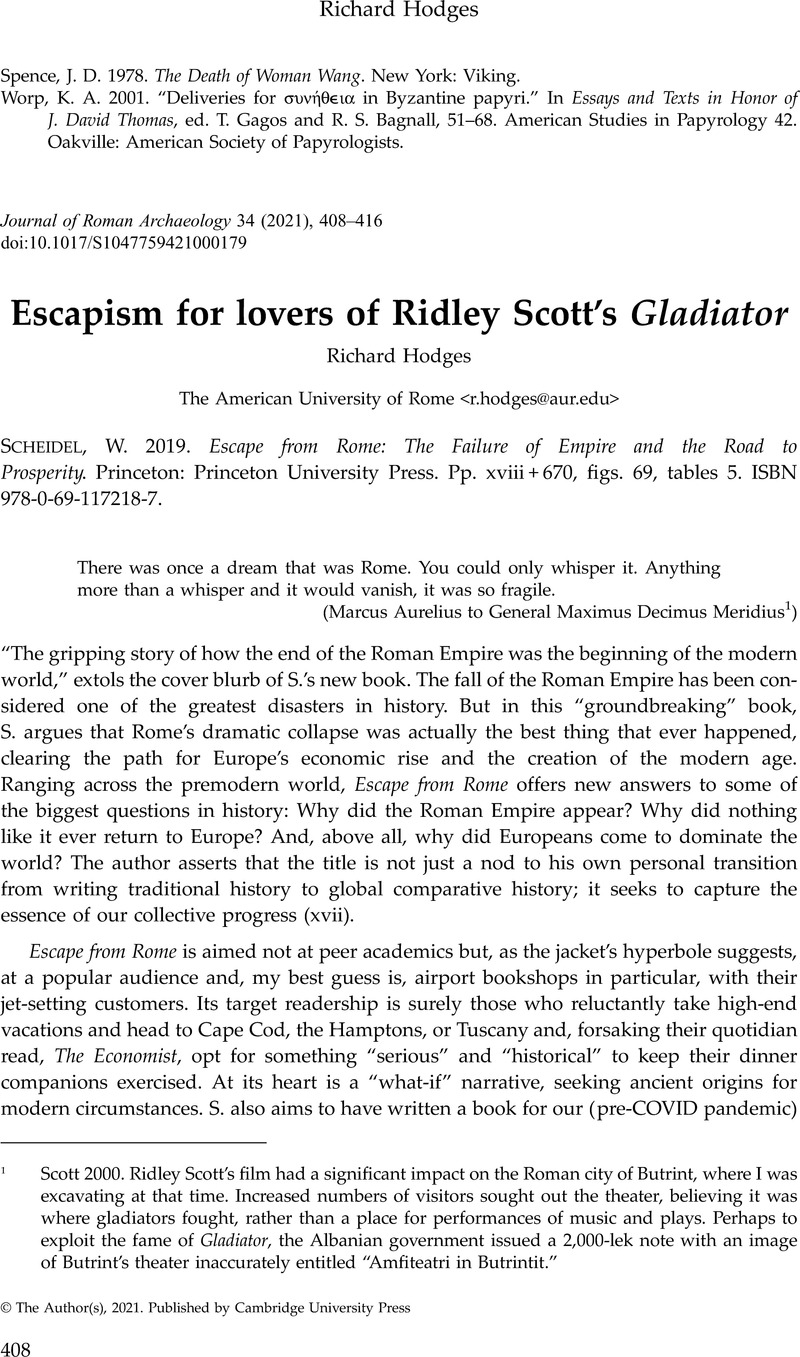No CrossRef data available.
Article contents
Escapism for lovers of Ridley Scott's Gladiator - W. Scheidel 2019. Escape from Rome: The Failure of Empire and the Road to Prosperity. Princeton: Princeton University Press. Pp. xviii + 670, figs. 69, tables 5. ISBN 978-0-69-117218-7.
Published online by Cambridge University Press: 12 April 2021
Abstract
An abstract is not available for this content so a preview has been provided. Please use the Get access link above for information on how to access this content.

- Type
- Book Review
- Information
- Copyright
- Copyright © The Author(s), 2021. Published by Cambridge University Press
References
Braudel, F. 1979. Civilization and Capitalism, 15th–18th Century. Vol 1: The Structures of Everyday Life. Translated by Reynolds, Siân. New York: Harper and Row.Google Scholar
Christie, N., and Hodges, R.. 2016. “Anxious abbots? Questions of defence and monastic communities in Early Medieval Europe.” In Fortified Settlements in Medieval Europe: Defended Communities of the 8th–10th Centuries, ed. Christie, N. and Herold, H., 137–55. Oxford: Oxbow Books.Google Scholar
Featherstone, M. 2009. “Occidentalism: Jack Goody and comparative history.” Theory, Culture and Society 26: 1–15.Google Scholar
Goody, J. 2010. Renaissances: The One or the Many? Cambridge: Cambridge University Press.Google Scholar
Hodges, R. 2015. “The idea of the polyfocal ‘town’? Archaeology and the origins of medieval urbanism in Italy.” In New Directions in European Medieval Archaeology: Essays for Riccardo Francovich, ed. Gelichi, S. and Hodges, R., 267–84. Turnhout: Brepols.Google Scholar
Kuhn, T. S. (1962) 2012. The Structure of Scientific Revolutions. Rev. ed. Chicago: University of Chicago Press.CrossRefGoogle Scholar
Randsborg, K. 2009. The Anatomy of Denmark: Archaeology and History from the Ice Age to the Present. London: Duckworth.Google Scholar
Renfrew, C., and Cherry, J. F., eds. 1986. Peer Polity Interaction and Socio-Political Change. Cambridge: Cambridge University Press.Google Scholar
Satia, P. 2020. Time's Monster: How History Makes History. Cambridge, MA: Harvard University Press.CrossRefGoogle Scholar
Sindbaek, S. M. 2020. “Communities on the edge: Retracing the northern emporia.” In Communautés maritimes et insulaires du premier Moyen Âge, ed. Gautier, A. and Malbos, L., 127–42. Turnhout: Brepols.CrossRefGoogle Scholar
Scott, R., dir. 2000. Gladiator. Universal City, CA: Dreamworks Home Entertainment, Universal Studios.Google Scholar
Theuws, F. 2004. “Exchange, religion, identity and central places in the Early Middle Ages.” Archaeological Dialogues 6: 121–38.CrossRefGoogle Scholar
Wallerstein, I. 1974. The Modern World-System I: Capitalist Agriculture and the Origins of the European World Economy. New York: Academic Press.Google Scholar
Weber, M. 1978. Economy and Society: An Outline of Interpretive Sociology. Ed. Roth, G. and Wittich, C.. Berkeley, CA: University of California Press.Google Scholar
Wickham, C. 1991. “Systactic structures: Social theory for historians.” PastPres 152: 188–203.Google Scholar
A correction has been issued for this article:
Linked content
Please note a has been issued for this article.




